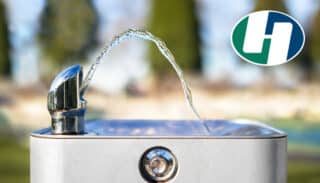EMERGENCY RESPONSE BEST PRACTICES :: PROTECTION AGAINST HYPOTHERMIA
Low ambient temperature and wind chill may simply be part of the job in cold climates, but they can have a lethal effect on exposed skin – particularly when combined with hazardous conditions where safety showers are required. This problematic combination creates a scenario for an ineffective and injurious emergency shower response. In some cases, inappropriate safety equipment can actually speed up the potential for cold-temperature related injuries like hypothermia. To ensure everyone’s safety, awareness and adherence to proper procedures and safety standards is critical.
UNDERSTANDING COLD-TEMP RELATED INJURY RISKS
Occupational Safety & Health Administration (OSHA) defines hypothermia as a cold-temp related injury in which normal body temperature drops to or below 95°F/35°C. Symptoms include drowsiness or fatigue, bluish skin, uncontrollable shivering, slurred speech and clumsy movements. Permanent tissue damage and death can result if hypothermia is left untreated.
EXPOSED FLESH in 0°F/17.8°C with 10mph wind
speed is in danger of hypothermia within 1-minute
Specific conditions in cold-weather climates can increase the risk of cold-temp related injuries, including hypothermia, which can affect a person even when land temperatures are above freezing or water temperatures are below 98.6oF/37oC. Factors influencing these injuries include:
• Low ambient temperatures and/or wind chill
• Wet skin, which freezes at a higher temperature than dry skin
• Exposed skin
While the ANSI Z358.1 Standard outlines suitable water temperatures as tepid – with a defined range of 60 to 100°F/15.5 to 37.77°C – and requires a full 15-minute drench period, the low end of this accepted temperature range can exacerbate the effects of hypothermia, particularly when exposure lasts the entire drench period. In addition, ANSI Z358.1 Appendix B6 states: Colder ambient temperatures might require an enclosure for added protection – even with water supplied in the ANSI Z358.1 specified temperature range, there is a high risk of hypothermia for wet victims exposed
to frigid ambient temperatures where loss of body heat is intensified by the effects of evaporative cooling and wind chill. It is crucial that the proper safety shower system is provided to prevent an incident where hypothermia could intensify an injury to a victim already in a hazardous situation.
SAFETY SOLUTIONS FOR COLD-WEATHER CLIMATES
Haws Integrated™ offers a variety of customized, ANSI compliant enclosed safety solutions for all climates. Features specific to equipment intended for use in cold-weather climates include combination units enclosed in booths with all-weather insulation, water-proof exterior coating, self-closing shower doors, built-in heaters, internal hot water supply and medically superior, non-injurious water flow, all of which qualify as industry best practices. Enclosures eliminate frigid environments by providing a shower area at a safe ambient temperature, out of the elements. Properly preparing a site for the use of climate specific equipment can mean the difference in minimizing or increasing the severe effects of cold-temperature injuries.
For more information, visit HawsIntegrated.com.




